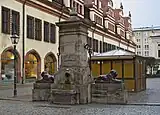The fountains in Leipzig were originally built as part of the city's water supply and in the 19th and 20th centuries others were added for decorative functions. They are regarded as objects of historical and art historical interest.
Water supply
Decorative
"Badender Knabe" and "Badendes Mädchen"
In connection with the restoration and reconstruction work of the Old City Hall at the marketplace from 1906 until 1909, there were built two fountains „Badender Knabe“ (German: Bathing knave, Sculptor: Carl Seffner) and „Badendes Mädchen“ (German: Bathing girl). They are in a niche inside and in front of the passage on the town hall's side towards the Naschmarkt. The sculpture of the girl has been made by Johannes Hartmann in 1906. After it has been stolen, it was recreated in 2000 by the Leipzig sculptor Klaus Schwabe.[1]
Löwenbrunnen
It is located on the Naschmarkt opposite the main entrance of the Madler Passage and was built in 1918, on the location of buildings dating from 1690. Its fountain is reached by three steps that surround it and is decorated with mythical creatures and marine sandstone reliefs. On the copper painted hood, there was a pyramid, crowned at the tip with a golden sun.[2]
Around 1820 there was a decorated pump handle in the form of an iron lion and designed by the Berlin sculptor Johann Gottfried Schadow and cast by Lauchhammert. It was incorporated into the lion fountain designed by the Leipzig Oberbaurat Hugo Licht. There is a Versalinschrift on the back of the fountain which reads "In the last war in 1918, this fountain in the shape of the old wooden housing has been rebuilt from the rate by the architect Dr. Ing. Hugo Lucht. The funds were donated by the Hugo Haschke Company."
 Decorative fountain Bathing knave
Decorative fountain Bathing knave Decorative fountain Bathing girl
Decorative fountain Bathing girl Lion Fountain (Löwenbrunnen)
Lion Fountain (Löwenbrunnen)
Mägdebrunnen

The Mägdebrunnen,[3] which was inaugurated on 31 May 1906 and was formerly located at the confluence of Seeburgstrasse and Sternwartenstrasse with Roßplatz, is now located in the northern corner of the Ringbebauung on Roßplatz. The funds required for its construction were raised by Leipzig residents living abroad. The fountain, created by the sculptor Werner Stein, consists of a six-sided water basin made of white shell limestone, with smaller water basins in front of it on three sides. Above these are capital inscriptions (“Whoever wants pure water must use pure jugs”, “Water takes everything away, just don’t talk badly”, “Whoever wants to drink must join”).
The centerpiece of the building is the life-size bronze figure of a woman carrying water on the central column decorated with lion heads, which refers to Lieschen from the fountain scene in Johann Wolfgang von Goethe's Faust I. The Mägdebrunnen was moved around 1955 as part of the redesign of Roßplatz and was extensively renovated in 1993.
Märchenbrunnen

The Märchenbrunnen (Fairytale fountain)[4][5] in the promenade at Dittrichring was created in 1906 by Josef Mágr. In the grotto of the middle section there are life-size bronze figures of the fairy tale characters Hansel and Gretel on a pedestal. Above this is a stone relief of a witch and a raven. Above the benches on both sides of the middle section there are two bronze reliefs that depict key scenes from the fairy tale (getting lost in the forest, discovering the crispy house, returning home).
The bronze parts of the fountain were removed in 1942 and used in the armaments industry. Since 1965, the fountain has been decorated with new figures designed by the Leipzig artists Elfriede Ducke and Hanna Studnitzka.
Mendebrunnen

The Mende Fountain is located at Augustusplatz in front of the Gewandhaus (Concert Hall). It is the largest fountain in Leipzig and cost 189,000 gold marks to construct. It was built by Adolf Gnauth in 1883–86. Pauline Mende, a merchant's widow, bequeathed her money to Leipzig for building a fountain. In honor to her Leipzig give the fountain her name.[6]
Rathausbrunnen
Villersbrunnen
References
- ↑ Wolfgang Hocquél, Leipzig. Architektur von der Romanik bis zur Gegenwart, Passage, 2nd extended edition, Leipzig 2004, ISBN 3-932900-54-5, p. 41, in German
- ↑ "Löwenbrunnen". leipzig-lexikon.de (in German). Retrieved 2024-01-16.
- ↑ Hocquél, Wolfgang (2023). Architekturführer Leipzig. Von der Romanik bis zu Gegenwart (in German). Leipzig: Passage-Verlag. p. 155. ISBN 978-3-95415-128-8.
- ↑ Hocquél (2023), p.137f.
- ↑ "Statues - Hither & Thither, Fairytale Fountain, Leipzig - Märchenbrunnen". statues.vanderkrogt.net. Retrieved 2024-01-16.
- ↑ Hocquél (2004), pp. 119/120
(Incorporates information translated from the German Wikipedia)